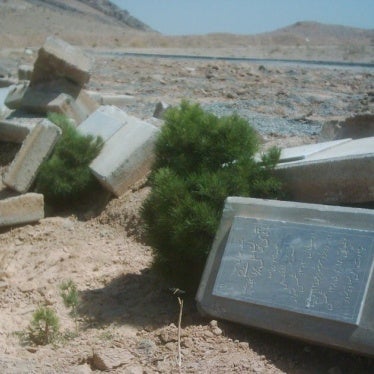Franklin P. Lamb's article "Is Human Rights Watch Caving to the Israeli Lobby?", published on September 4, 2007, is full of broad allegations of bias that are unsubstantiated and unworthy of response. However, his challenge to the methodology and evidence in our report "Civilians under Assault: Hezbollah's Rocket Attacks on Israel in the 2006 War," (https://www.hrw.org/reports/2007/iopt0807/) merits closer scrutiny and a response.
The main conclusion of "Civilians under Assault" is that Hezbollah "repeatedly bombarded cities, towns, and villages without any apparent effort to distinguish between civilians and military objectives. In doing so, Hezbollah, as a party to an armed conflict governed by international humanitarian law, violated fundamental prohibitions against deliberate and indiscriminate attacks against civilians....In some of those cases, we could find no evidence there had been a legitimate military target in the vicinity at the time of the attack, suggesting it was a deliberate attack on civilians."
As an initial matter, contrary to what Lamb writes, Human Rights Watch does not oppose (or endorse) "the right to resist" of Hezbollah or the Palestinian people - or of any armed group anywhere in the world. We simply hold Hezbollah, as we hold any party to an armed conflict, whether a state or an armed group, to its obligations under international humanitarian law to spare, to the greatest extent possible, civilians from harm during armed conflict.
Lamb's main criticism seems to be that Human Rights Watch discounted the presence of Israeli military objectives placed in civilian areas, which would undermine our finding that Hezbollah's attacks amounted to a pattern of indiscriminate and sometimes deliberate attacks on civilians. Lamb either missed or ignored the several instances where we indeed documented the presence of Israel Defense Force (IDF) troops or weapons in the vicinity of a Hezbollah rocket attack. I know of no other public document that identifies so many Israeli military objects situated near some of the civilian areas that Hezbollah rockets hit, such as the naval base adjacent to Rambam Hospital in Haifa, the IDF northern command in Safed, the Raphael defense industry campus north of Kiryat Yam, and artillery pieces near Arab al-Aramshe and Kiryat Shmona. And we accordingly criticized Israel for failing in its duty to avoid endangering civilians by placing military assets in populated areas.
Yet the presence of IDF military assets in populated areas does not absolve Hezbollah of culpability for indiscriminately firing into them: that is, even if Hezbollah had a military target in mind, it failed to take precautions, in its targeting and its use of weapons, to distinguish between military and civilian objects in order to minimize civilian loss. Human Rights Watch similarly criticized Israel for failing to discriminate between legitimate Hezbollah military targets and civilians in its bombing of southern Lebanon. Furthermore, Lamb does not account for the numerous instances where we found no evidence of any IDF military target in civilian areas that Hezbollah nevertheless repeatedly targeted.
Lamb complains that we acknowledge Israeli censorship of news about successful Hezbollah strikes on Israeli military targets but then ignore the extent to which it calls our findings into doubt. As a human rights organization, we focus on attacks that kill and injure civilians and determine whether they violated international humanitarian law. So whether Hezbollah hit military objects more than is known is neither relevant to our analysis nor would excuse the scores of Hezbollah's indiscriminate and deliberate attacks on civilian areas.
The attacks on Nahariya and Karmiel are illustrative. Hezbollah struck these two cities with hundreds of rockets throughout the course of the war, hitting residential neighborhoods in various parts of each city. Based on site visits and interviews, we concluded that there were no significant military objectives in either city, although there are defense industries located near, but outside, both. Our conclusion was that Hezbollah set out deliberately to hit these cities, in violation of the laws of war. Even if it turned out that we had overlooked a military target in either town, its presence would not justify Hezbollah's firing of hundreds of rockets that landed all over Nahariya and Karmiel not on one or two days, but over an entire month.
Lamb also assails Human Rights Watch for accusing Hezbollah commanders of war crimes without having the requisite evidence to back up such serious charges. We stand by our findings. Firing deliberately or indiscriminately at civilians with criminal intent is a war crime. Our report quotes many statements by Hezbollah leaders indicating their intent to fire indiscriminately if not deliberately at civilian areas. For example, Secretary-General Hassan Nasrallah stated on July 29, 2006:
When, throughout the Arab-Israeli conflict [have] 2 million Israelis [been] forced [before] to leave their areas or stay in shelters for 18 days or more? This number will increase when we expand the "beyond-Haifa" stage. The shelling of the city of Afula and its military base represented the beginning of this stage. Many cities in the centre will be a target in the beyond-Haifa stage if the barbaric aggression against our homeland, people, and villages continues.
This indication of intent, when coupled with the evidence we collected on the ground of deliberate and indiscriminate attacks on civilians, is evidence of war crimes, regardless of the justifications Hezbollah may have offered for pursuing this policy.
Lamb's critique of Human Rights Watch's methodology is familiar because it resembles the arguments used by many of those who seek to discredit our finding that Israel's indiscriminate fire was the main cause of Lebanese civilian deaths during the 2006 war. (See our report "Why They Died: Civilian Casualties in Lebanon during the 2006 War" (https://www.hrw.org/reports/2007/lebanon0907/). These critics assert that if Human Rights Watch found almost no Hezbollah presence near Lebanese civilians when Israeli fire killed them, it is because of flaws in our methodology: that we relied on untrustworthy Lebanese witnesses, or that we lacked access to the classified, real-time intelligence the Israeli army used concerning Hezbollah's whereabouts.
Some Lebanese and Israeli witnesses may have been uninformed or untruthful when answering our questions about the proximity of military objects at the time of enemy attacks. But in both our reports on Israel and Lebanon, we explain the additional evidence that supports our conclusions as to the nature of the attacks in their midst. In Israel, we interviewed whenever possible both Jewish and Arab eyewitnesses, favoring those whose testimony could be corroborated by other independent testimonies or physical evidence; we conducted on-site visits; and we monitored Hezbollah's declarations to the media about specific attacks it carried out.
I invite readers to consult the reports and judge for themselves.
In closing, writing in a strictly personal capacity, I am repelled by Lamb's assertion that "70 percent of [Human Rights Watch's] budget [is] estimated to be provided by Jewish contributors." Make no mistake: this unsourced and factually untrue statement is anti-Semitic and not anti-Zionist. It perpetuates the time-worn canard that all Jews share a political agenda - Israel right or wrong - and that with their lucre they pull the strings behind the scenes.
Eric Goldstein is the research director of the Middle East and North Africa Division of Human Rights Watch and principal author of "Civilians under Assault: Hezbollah's Rocket Attacks on Israel in the 2006 War."







